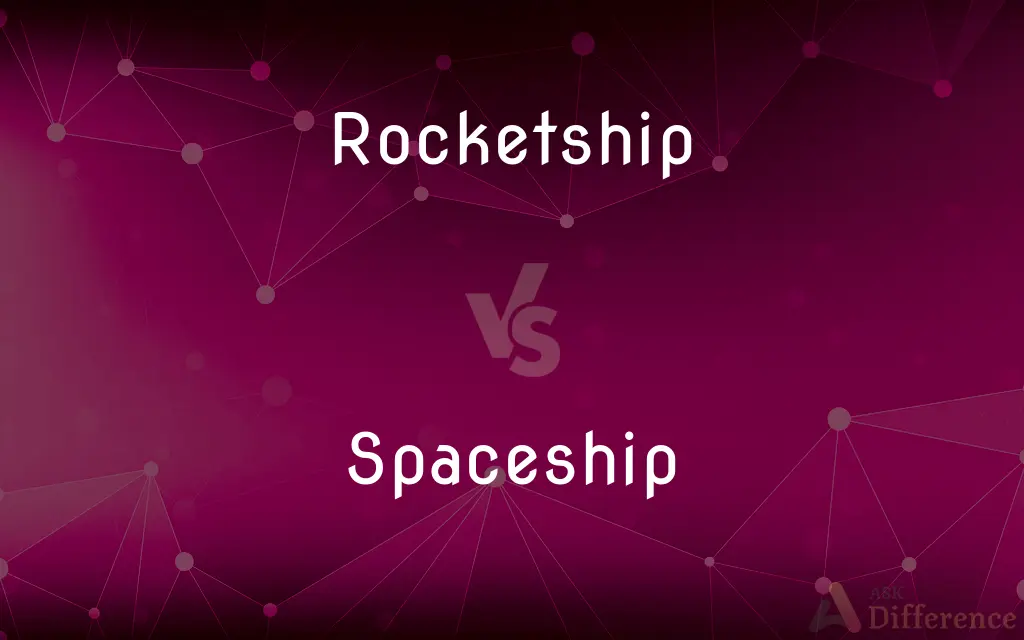Rocketship vs. Spaceship — What's the Difference?
Edited by Tayyaba Rehman — By Maham Liaqat — Updated on April 20, 2024
A rocketship is specifically designed for launch and propulsion, using rockets, while a spaceship refers to any vehicle designed for space travel.

Difference Between Rocketship and Spaceship
Table of Contents
ADVERTISEMENT
Key Differences
A rocketship utilizes rocket engines for propulsion, focusing on overcoming Earth's gravity to reach space. It is typically used to describe vehicles involved in the initial stages of space travel. On the other hand, a spaceship encompasses a broader category of spacefaring vehicles, which may include those designed for orbit, lunar, or interplanetary travel.
Rocketships are characterized by their use of rocket engines that expel exhaust to generate thrust according to Newton's third law. This is crucial for lifting off from the Earth’s surface. Whereas, spaceships can be equipped with various propulsion systems, depending on their mission requirements, including ion thrusters or nuclear propulsion for deep space missions.
In terms of design, rocketships often have a more streamlined and aerodynamic structure to handle the intense atmospheric pressure during launch. In contrast, spaceships that operate solely in the vacuum of space can have varied designs that do not require aerodynamic considerations.
The term rocketship often implies a craft capable of returning to Earth, typically featuring stages that detach upon fuel depletion. Spaceships, however, might include vehicles like space stations or modules designed for prolonged use in space, not intended for Earth re-entry.
Rocketships are generally part of larger systems; for example, the booster rockets used in the Space Shuttle program. On the other hand, a spaceship could be a self-contained unit like the Starship by SpaceX, which is designed for both Earth orbit and potential Mars missions.
ADVERTISEMENT
Comparison Chart
Primary Function
Launch propulsion
Travel and operation in space
Propulsion Type
Rocket engines
Various types, including rocket, ion, nuclear
Design Focus
Aerodynamic, for atmospheric exit
Variable, primarily for vacuum operation
Usage Context
Often implies Earth to space and back
Broad, including orbit, lunar, interplanetary
Example
Saturn V rocket
International Space Station
Compare with Definitions
Rocketship
Multi-stage.
Rocketships often have multi-stage designs to efficiently use fuel and manage weight.
Spaceship
Spacecraft.
The term spaceship encompasses all types of spacecraft, from satellites to crewed lunar vehicles.
Rocketship
Expendable.
Traditional rocketships are often expendable, with stages that are discarded after fuel depletion.
Spaceship
Orbital Maneuvering.
Spaceships are equipped with systems for orbital maneuvering and docking.
Rocketship
Rocket Propulsion.
Rocketships rely on rocket propulsion to escape Earth’s gravitational pull.
Spaceship
Long-duration Missions.
Spaceships like the ISS are designed for long-duration missions, supporting crews for months.
Rocketship
Re-entry Capability.
Many rocketships are designed to withstand the harsh conditions of re-entering Earth's atmosphere.
Spaceship
Varied Propulsion.
Modern spaceships might use ion thrusters for more efficient space travel.
Rocketship
Launch Vehicle.
The Saturn V was a rocketship used to propel astronauts to the Moon.
Spaceship
Modular Design.
Some spaceships feature a modular design, allowing for assembly and upgrades in space.
Rocketship
A rocket-powered spacecraft.
Spaceship
A spacecraft, especially one controlled by a crew.
Spaceship
See spacecraft.
Spaceship
(astronautics) A vehicle that flies through space.
Spaceship
A finite pattern that reappears after a certain number of generations in the same orientation but in a different position.
Spaceship
(programming) The operator
<=> in certain programming languages, which compares two values and indicates whether the first is lesser than, greater than, or equal to the second.Spaceship
A spacecraft designed to carry a crew into interstellar space (especially in science fiction)
Common Curiosities
What kind of propulsion systems do spaceships use?
Spaceships may use rocket engines, ion thrusters, nuclear propulsion, or other technologies, depending on their mission.
Why do rocketships need to be aerodynamic?
Rocketships need aerodynamic designs to efficiently pass through Earth's atmosphere during launch.
Can all rocketships be considered spaceships?
Yes, all rocketships can be considered a type of spaceship, specifically designed for launch and re-entry.
What is the primary purpose of a rocketship compared to a spaceship?
Rocketships are primarily used for launching from Earth, while spaceships are designed for various tasks in space.
Are spaceships always capable of returning to Earth?
Not all spaceships are designed to return to Earth; some, like space stations, are intended for prolonged use in orbit.
How are spaceships adapted for long-duration space travel?
Spaceships designed for long missions may have life support systems, shielding against cosmic radiation, and systems for recycling water and air.
What are examples of rocketships and spaceships?
Examples of rocketships include the Falcon Heavy and the Space Shuttle, while the International Space Station and the Hubble Space Telescope are examples of spaceships.
How do design considerations differ between rocketships and spaceships?
Design considerations for rocketships include dealing with atmospheric conditions, whereas spaceships focus on functionality in the vacuum of space.
Can spaceships operate without human crews?
Yes, many spaceships are unmanned, designed for tasks such as satellite deployment, scientific research, or exploration.
How do rocketships manage the intense heat during re-entry?
Rocketships use heat shields that absorb or deflect the extreme heat generated during atmospheric re-entry.
What innovations are being made in spaceship propulsion?
Innovations include developments in ion propulsion and nuclear thermal rockets to improve efficiency and reduce travel time in space.
How do advancements in spaceship technology impact human space exploration?
Advances in spaceship technology, such as improved life support and propulsion systems, expand the possibilities for human exploration of deeper space.
What is the significance of multi-stage rocketships?
Multi-stage designs in rocketships help manage the efficient use of fuel and reduce weight as the vehicle ascends.
What role do rocketships play in satellite deployment?
Rocketships are used to carry satellites into orbit, deploying them at precise altitudes and trajectories.
What are the environmental impacts of rocketships?
The launch of rocketships can have environmental impacts, including atmospheric pollution and potential harm to local wildlife.
Share Your Discovery

Previous Comparison
Bishop vs. Abbot
Next Comparison
Cladded vs. CladAuthor Spotlight
Written by
Maham LiaqatEdited by
Tayyaba RehmanTayyaba Rehman is a distinguished writer, currently serving as a primary contributor to askdifference.com. As a researcher in semantics and etymology, Tayyaba's passion for the complexity of languages and their distinctions has found a perfect home on the platform. Tayyaba delves into the intricacies of language, distinguishing between commonly confused words and phrases, thereby providing clarity for readers worldwide.














































